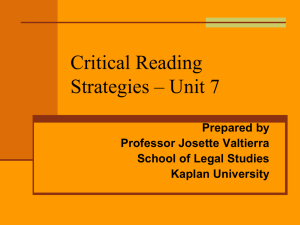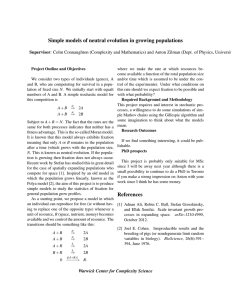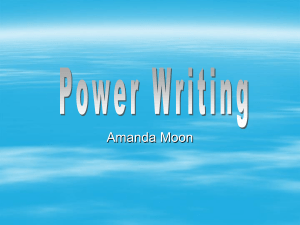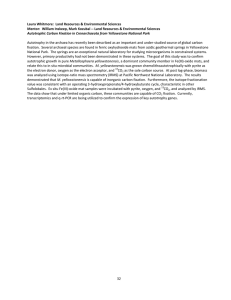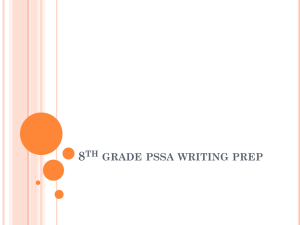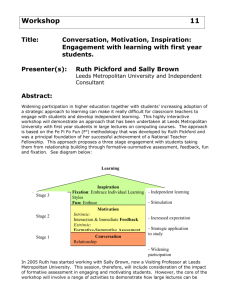Read
advertisement
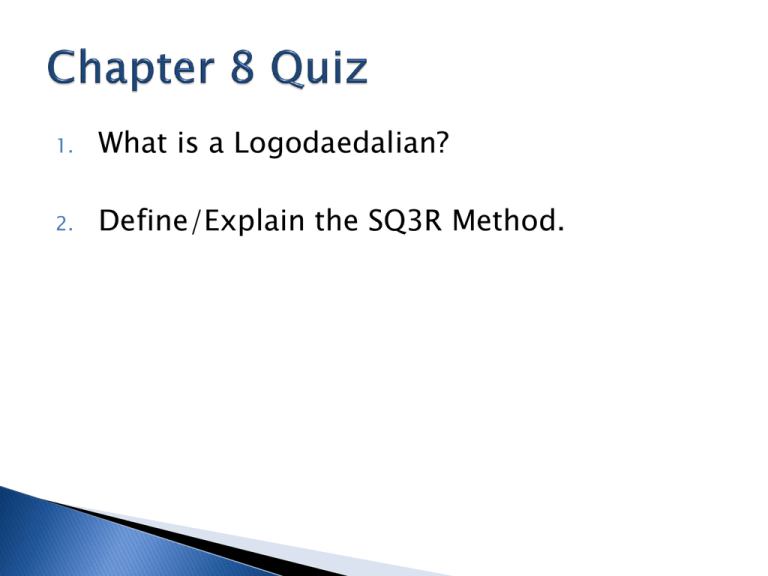
1. What is a Logodaedalian? 2. Define/Explain the SQ3R Method. Chapter Eight: Read College math courses and Reading comprehension Active readers tend to approach assignments with a positive, open mind: ◦ “I’m going to learn from this.” “I think I can apply this to my life now” Passive readers tend to have a negative attitude about reading: ◦ “This stuff is worthless.” http://www.online-stopwatch.com/fullscreen-stopwatch/ Rate Calculator for Relatively Easy Passages Time in Seconds and Minutes Words Per Minute 50 464 60 (1 min) 387 120 (2 min) 194 130 179 140 165 150 155 160 145 170 137 180 (3 min) 129 200 116 Comprehension Results 1. 2. 3. 4. 5. True True False True False Conclusions Average reading speed is 250 words/minute Average textbook page has 450 words Speed/Comprehension scores are raw numbers for basic reading ◦ Does not allow for marking, highlight, note taking, etc ◦ Coupling these skills with basic reading can TRIPLE the required reading time. Not concentrating on the passage (thinking about other things) Vocabulary words with which you are not familiar Stopping too long on any given single word (Fixation – discussed later) Not reading often enough to build your speed. A person who has a great passion for unique, sly, and clever words and phrases. Develop a dynamic vocabulary by reading Look up unfamiliar words in a collegiate dictionary Jot down the best definition in the margin of your text Increasing your Concentration ◦ Reduce outside distractions such as people talking, poor climate conditions (cold/hot), televisions, etc. ◦ Reduce internal distractions such as fatigue, selftalk, daydreaming, hunger, etc. ◦ Take short breaks every 20 minutes, but don’t get distracted, come back in 3-5 minutes. ◦ Take notes as you read Increasing your Vocabulary ◦ If you do not know a word – stop and look it up. ◦ If you are “in the zone” – mark the word, and look it up at your 20 minute break, then re-read the passage. ◦ The more words you learn, the less often you will have to break your concentration. ◦ It is nearly impossible to read, comprehend, and remember a passage when you do not know or understand one or more words. Reducing your Fixation ◦ Fixation is when your eyes stop on a single word to read it. ◦ The average reader sees approximately 2.5 words per fixation ◦ Reduce fixation through practice. Try seeing two or more words with one fixation. Developing this skill requires PRACTICE The topic is the main idea of the paragraph – identifying the main idea of a paragraph can greatly aid your comprehension. ◦ You can identify the topic by answering the question: “Who or what is this paragraph about?” ◦ Topic statements should be general enough to over all of the specifics of the paragraph. ◦ Topic statements should be specific enough to exclude other paragraphs. Practicing these steps of identifying the main idea will help you learn to do it naturally. S = Scan Q = Question R = Read R = Recite R = Review Only effective when used on a regular basis, useless as a method for cramming. The method is time consuming, but highly effective. Read the title, headings, and subheadings of the chapter. Look at bold terms and graphic material (timelines, graphs, charts, pictures, etc). If there is a chapter summary, read it. Read first and last sentence of each paragraph. Scanning IS NOT a substitute for reading a chapter. Turn major chapter headings into questions Ask “Who? What? When? Where? Why?” type questions. If you cannot answer these questions after scanning, you should search for the answers while reading READ THE CHAPTER Read paragraphs chronologically, don’t jump around – paragraphs build on one another. Take notes and highlight as you read. ◦ ◦ ◦ ◦ ◦ Read an entire paragraph before marking Identify and mark the main point Highlight key ideas Beware of overmarking text Stop to look up unfamiliar words Take complete notes, beyond highlighting and scribbles in the margin ◦ See page 163 for Sample Note-Take Methods After reading the chapter, ask yourself: “What was that all about?” Discuss the chapter with a classmate, ask questions. Recite alone or with a study partner, if you can’t explain the chapter to yourself or someone else, you didn’t understand the material. Final step for comprehension – RE-read the chapter. Survey and read text again. Answer questions you developed. Determines whether you have mastered the information. Stores and retains the information in long term memory. Approach text with an open mind Free your mind of distractions so you can focus Read with your “six pack” Look up words you don’t know Record vocabulary words to review Use SQ3R The more you use your reading skills, the better you’ll become at reading and comprehending If you’re having trouble, ask for help. (Professor, Academic Centers, Excel Center, Tutor) Wednesday we will be meeting in TLC 1116. Journal Assignments due (free write or Dr Horrible). Email your group members to me by the end of October, if you are having trouble finding partners, let me know by Oct 25th.

